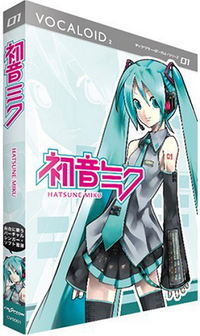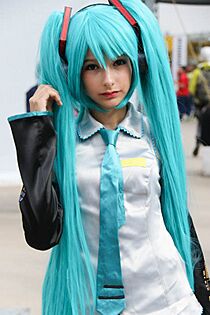Hatsune Miku facts for kids
 |
|
 |
|
| Developer(s) | Crypton Future Media |
|---|---|
| Initial release | August 31, 2007 |
| Stable release |
Hatsune Miku NT V2 (New Type Version 2) / March 18, 2025
|
| Operating system | Microsoft Windows, macOS |
| Platform | PC |
| Available in |
|
| Type | Vocal synthesizer application |
| License | Proprietary (Vocaloid voice/software) Creative Commons BY-NC (character design) |
Hatsune Miku (Japanese: 初音ミク), also known by her code name CV01, is a famous virtual singer from Japan. She is not a real person, but a computer program called a Vocaloid. This software allows anyone to create songs by typing in lyrics and a melody.
Miku is known for her unique look: a 16-year-old girl with long, turquoise pigtails. She has become a virtual idol and even performs concerts as a hologram on stage.
Her voice was created using a technology called a singing synthesizer. The voice samples were provided by a Japanese voice actress named Saki Fujita. Miku was the first of a series of characters called the "Character Vocal Series." Her name means "the first sound of the future" in Japanese. You can see the number 01 on her left shoulder in her official art.
Contents
The Creation of a Virtual Singer
Hatsune Miku was created by a Japanese company called Crypton Future Media. When they were developing her, they decided she needed more than just a great voice—she needed a memorable character to go with it.
The job of designing Miku was given to a manga artist named Kei Garō. He was told to create an android (a robot that looks like a person) with a turquoise color scheme. Many parts of her outfit, like the keyboard on her sleeve, were inspired by real music synthesizers.
To create her voice, actress Saki Fujita recorded many different sounds. These sounds were then put into the Vocaloid software. Music producers can arrange these sounds to make Miku sing any song they write.
Hatsune Miku was first released on August 31, 2007. Over the years, she has been updated many times, and can now sing in Japanese, English, and even Chinese.
Giving Miku Different Voices
To make Miku even more versatile, Crypton released an add-on called Hatsune Miku Append. This gave her six new voice styles, or "timbres." These included:
- Soft: A gentle and delicate voice.
- Sweet: A young and cute voice.
- Dark: A mature and sad-sounding voice.
- Vivid: A bright and cheerful voice.
- Solid: A loud and clear voice.
- Light: An innocent and angelic voice.
These "Appends" allowed creators to make songs with more emotion and variety. Later versions of her software, like Hatsune Miku V4X, added even more features, allowing for more realistic and expressive singing.
Becoming a Global Star
Hatsune Miku quickly became very popular in Japan. Soon after her release, she was the best-selling software on Amazon Japan. Her success was so big that it surprised even her creators.
Because of her popularity, Miku began to appear on all sorts of merchandise, from toys to clothing. She is now one of the most recognizable characters from Japan. In 2011, her music started being sold in the United States, where she also gained a large following.
Good Smile Racing

Hatsune Miku is so popular she even sponsors a real race car team called Good Smile Racing! Since 2008, the team has competed in racing events with cars decorated in Miku's image.
Each year, a special "Racing Miku" design is created by a different artist. This means her look on the cars changes every season, making each year's design unique and exciting for fans. The team has competed in many races and has become a fan favorite.
Snow Miku Festivals
Every winter, the city of Sapporo in Japan holds a snow festival. Since 2010, Hatsune Miku has been a big part of the celebration. A special version of her, called "Snow Miku," is created for the event.
Each year, a new Snow Miku design is chosen through a contest. Fans get to vote on their favorite design, which is then used for merchandise and giant snow sculptures at the festival. Snow Miku has become a beloved winter tradition.
Why Is Hatsune Miku So Famous?
A big reason for Miku's fame is the website Nico Nico Douga, which is similar to YouTube. After Miku was released, users began creating songs with her software and uploading videos to the site.
One of the first viral videos showed a cute, chibi version of Miku, called Hachune Miku, singing a Finnish song called "Ievan Polkka". In the video, she was spinning a spring onion. This video was so popular that the spring onion (or leek) became Miku's signature item.
This showed that anyone could use Miku to create their own music, art, and animations. Fans started working together to create amazing content, and a huge online community grew around her.
Miku's popularity reached new heights when her fans successfully petitioned to have her image sent into space! In 2010, three small aluminum plates with pictures of Miku were placed on the Japanese spacecraft Akatsuki, which was sent to explore the planet Venus.
Miku in Games, Shows, and Music
Hatsune Miku has appeared in many different forms of media outside of her music software. She is a true pop culture icon.
Video Games
Miku is the star of her own series of rhythm games, starting with Hatsune Miku: Project DIVA made by Sega. In these games, players tap buttons in time with her songs. Another popular mobile game is Project Sekai: Colorful Stage!.
She has also appeared as a special character in many other games, including Fortnite Festival, Just Dance 2016, and Persona 4: Dancing All Night. Her outfits are also available as costumes in games like Phantasy Star Online 2.
Anime and Manga
Miku has her own manga series called Maker Hikōshiki Hatsune Mix. She has also made guest appearances in several anime series, such as Shinkalion and Dropkick on My Devil! X.
Music and Concerts
As a virtual idol, Hatsune Miku performs "live" concerts for thousands of fans. She appears on stage as a 3D projection, or hologram, and sings and dances alongside a live band. She has performed sold-out shows all over the world, from Tokyo to Los Angeles.
Miku has also collaborated with famous musicians.
- She was the opening act for Lady Gaga's ArtRave: The Artpop Ball tour in 2014.
- Pharrell Williams created a remix of her song "Last Night, Goodnight."
- She performed on American TV on the Late Show with David Letterman.
- She has been a featured performer at the famous Coachella music festival.
With over 100,000 unique songs created by fans and producers worldwide, Hatsune Miku continues to be a global phenomenon, showing how technology and creativity can come together to create a new kind of star.
In 2023, a special collaboration between Pokémon and Hatsune Miku was announced, called Project Voltage. This project featured 18 songs and music videos, each combining the world of Pokémon with Miku's music.


